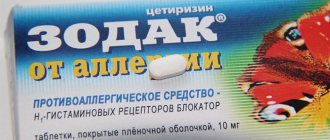Pharmacological properties of the drug Regulax picosulfate drops
Sodium picosulfate is a contact laxative that irritates receptors in the intestinal mucosa. Activated in the large intestine under the influence of bacterial sulfatases; the substance that is released stimulates the sensitive nerve endings of the intestinal mucosa, enhancing its motility. The laxative effect of sodium picosulfate is not accompanied by tenesmus and intestinal spasms. In infants, the effectiveness of sodium picosulfate may be insufficient due to the small amount of bacterial flora that produces sulfatases. Regulax Picosulfate drops are a drug that regulates intestinal function, increasing the volume of stool and enhancing peristalsis (natural rhythmic movement), promoting timely, painless bowel movements. The laxative effect occurs after 10–12 hours. Sodium picosulfate is absorbed in the small intestine only in limited quantities and has virtually no systemic effect. After the sulfate ester is broken down by bacteria in the large intestine, a diphenolic laxative is formed, which is partially absorbed and, after conjugation, is excreted in the bile. A small portion is excreted in the urine as a glucuronide; most of it is in the feces, both in the form of free diphenol and in the form of picosulfate itself.
Regulax Picosulfate (vial 7.5 mg/ml 20 ml)
A country
Germany
The country of production may vary depending on the batch of goods. Please check with the operator for detailed information when confirming your order.
Active substance
Sodium picosulfate
Compound
Active substance: sodium picosulfate monohydrate 7.5 mg.
pharmachologic effect
Laxative. Reduces the absorption of electrolytes and water, enhances intestinal motility. The active form of the drug, formed by hydrolysis under the influence of intestinal microorganisms, directly excites the nervous structures of the intestinal wall, resulting in accelerated movement of intestinal contents. The action occurs 10-12 hours after administration. Pharmacokinetics. After oral administration, it is not absorbed from the gastrointestinal tract and is not subjected to hepatic-intestinal circulation.
Indications for use
Atonic constipation. Regulation of stool (hemorrhoids, proctitis, anal fissures). Preparation for surgical operations, instrumental and x-ray examinations.
Mode of application
Inside, before bedtime. Depending on the effect obtained, the dose at subsequent doses is increased or decreased. Adults: initial dose - 13 drops, for persistent constipation - up to 26 drops. For children over 4 years old, the initial dose is 5-8 drops. The course of treatment is 7 days.
Interaction
Increased sensitivity to cardiac glycosides is possible. Glucocorticosteroids and diuretics increase the risk of developing electrolyte disturbances. Broad-spectrum antibiotics reduce the laxative effect. Possible increased sensitivity to cardiac glycosides.
Side effect
Diarrhea, abdominal pain, dehydration, water and electrolyte imbalance, weakness, cramps, decreased blood pressure.
Contraindications
Hypersensitivity, intestinal obstruction, strangulated hernia, acute inflammatory diseases of the abdominal organs. Peritonitis, abdominal pain (of unknown origin), severe dehydration, bleeding from the gastrointestinal tract, metrorrhagia, cystitis, spastic constipation, children (up to 4 years), pregnancy (1st trimester).
Overdose
Symptoms: see section "Side effects". In addition, with chronic overdose, ischemia of the colon mucosa, secondary hyperaldosteronism, urolithiasis, and damage to the renal tubules may develop. Treatment: gastric lavage, correction of water-electrolyte imbalance, antispasmodics.
special instructions
With caution: lactation period. Use during pregnancy. Contraindicated in the first trimester of pregnancy. Repeated use of the drug during the second and third trimesters should be carried out only after a thorough assessment of the need and risks, since there is not enough information on the use of the drug during pregnancy. It should not be taken without medical supervision for more than 7 days. Long-term use often leads to increased intestinal hardening. Should be used in children only in consultation with a doctor.Instructions for patients with diabetes.Suitable for patients with diabetes; contains sugar substitutes.
Indications for use of the drug Regulax picosulfate drops
Intestinal atony, constipation (except for spastic constipation), caused by changes in the nature and diet, prolonged immobilization, fever, severe general condition, diseases of the cardiovascular system and metabolic disorders; used in the pre- and postoperative periods, in obstetric and gynecological practice, to facilitate defecation in case of hemorrhoids, anal fissures, inoperable hernias, myocardial infarction, severe hypertension (arterial hypertension), to cleanse the intestines before instrumental examination.
Regulax
In the pharmacological coordinate system, Regulax cubes wrapped in embossed aluminum foil are probably as recognizable as Maggi cubes in the gastronomic system. Regulax is a well-known brand among laxatives, the brainchild of a German pharmaceutical company. This herbal preparation, as a pharmacologically active component, contains a phytotherapeutic “cocktail” in the form of senna leaves, leaves and fruits of senna angustifolia. Additionally, Regulax contains a whole scattering of excipients that make it possible to give the medicinal substance such a unique (in Russia there is no longer a single drug registered in the form of cubes for chewing) form: paraffin, fat, propylene glycol, etc., as well as a set of “goodies” like fig paste, plum mousse, sugar syrup.
According to approximate statistics, but definitely close to the true state of affairs, constipation occurs in 30% of people, regardless of their gender, age and position in society. Identifying this disease is absolutely not difficult: if there is a history of straining, hard stools resembling goat or sheep balls, the urge to defecate is not supported by excremental arguments, then this is it in person. There are also more specific markers of constipation, dressed in “dry numbers”: weekly frequency of bowel movements (less than three times) and daily weight of feces (less than 35 grams). It’s unlikely that anyone will dare to weigh their “industrial waste” on a scale, but everyone can count the number of visits to the bathroom “in a big way.” Treatment of constipation is a whole area in gastroenterology, which is by no means limited to pharmacological therapy.
The first step here is to modify your lifestyle and diet. The second (if there are no results) is the prescription of swelling and osmotic laxatives, coupled with physiotherapeutic procedures aimed at the pelvic floor area. And only then comes the turn of contact (the most effective) laxatives, among which regulax takes its place of honor. Its pharmacological effect develops 8-12 hours after administration. The mechanism of action of Regulax is to excite the receptors of the mucous membrane of the wall of the large intestine, which reacts to such an unceremonious invasion of its unhurried way of life by increasing the frequency and amplitude of peristaltic contractions, which entails a more rapid release of intestinal contents to the outside and restores the previous functional state of the digestive tract. Regulax is not addictive and does not have a negative effect on the digestive processes. The assets of this drug should include its nearly quarter-century of experience in use and the respectful (bordering on quiet admiration) attitude of gastroenterologists towards it. Russian medical periodicals even provided statistics from a survey of doctors regarding their preferences in prescriptions for the treatment of constipation. Regulax was mentioned by more than 70% of respondents. Despite the relativity of these statistics, it should be recognized that they still provide some food for thought. Of course, this drug is not the best one: on Russian pharmacy shelves you can find its cheaper Indian analogues (Senade, Glaxenna). In any case, the choice remains with the patient, especially since senna preparations can be purchased at the pharmacy without a doctor’s prescription.
Special instructions for the use of Regulax picosulfate drops
The drug Regulax Picosulfate drops is intended for short-term use. During pregnancy, the use of the drug is possible only under strict indications and under the supervision of a doctor. While using the drug, you should stop breastfeeding. The drug can be used for diabetes mellitus, since it contains a sugar substitute (1 ml of drops contains 0.03 XE). The drug should be used with caution after operations on the gastrointestinal tract or in case of dehydration. No addiction was observed with long-term use.
Regulax Picosulfate drops for internal use 20ml
Compound
Active substance: sodium picosulfate monohydrate 7.5 mg.
Excipients: sorbitol solution 70% (non-crystallizing) - 651.4 mg, propylene glycol - 200 mg, purified water - 308 mg.
Pharmacokinetics
After oral administration, it is not absorbed from the gastrointestinal tract and does not undergo hepatic-intestinal circulation.
Indications for use
- Atonic constipation;
- regulation of stool (hemorrhoids, proctitis, anal fissures);
- preparation for surgical operations, instrumental and x-ray examinations.
Contraindications
- Hypersensitivity to the drug;
- intestinal obstruction;
- strangulated hernia;
- acute inflammatory diseases of the abdominal organs;
- peritonitis;
- abdominal pain (of unknown origin);
- bleeding from the gastrointestinal tract;
- metrorrhagia;
- cystitis;
- severe dehydration;
- spastic constipation;
- children under 4 years of age;
- I trimester of pregnancy.
With caution: lactation period (breastfeeding).
Directions for use and doses
Inside, before bedtime. Depending on the effect obtained, the dose at subsequent doses is increased or decreased. Adults: initial dose - 13 drops, for persistent constipation - up to 26 drops. For children over 4 years old, the initial dose is 5-8 drops. The course of treatment is 7 days.
Storage conditions
The drug should be stored out of the reach of children at a temperature of 15° to 25°C.
Best before date
5 years.
Do not use after the expiration date stated on the package. Shelf life after opening the bottle is 6 months.
special instructions
Should not be taken without medical supervision for more than 7 days. Long-term use often leads to increased intestinal hardening.
Should be used in children only with the advice of a doctor.
Instructions for patients with diabetes mellitus
Suitable for diabetics; contains sugar substitutes; 1 ml corresponds to 0.03 XE.
Description
Laxative.
Use in children
Should be used in children only with the advice of a doctor.
Contraindicated in children under 4 years of age.
Pharmacodynamics
Laxative. The active form of the drug, formed by hydrolysis under the influence of intestinal microorganisms, directly stimulates the nervous structures of the intestinal wall, as a result of which the movement of intestinal contents accelerates and the absorption of electrolytes and water decreases. The effect occurs 10-12 hours after administration.
Side effects
Possible: diarrhea, abdominal pain, bloating, dehydration, water and electrolyte imbalance, weakness, cramps, decreased blood pressure.
Use during pregnancy and breastfeeding
Use is contraindicated in the first trimester of pregnancy. Repeated use of the drug during the second and third trimesters should be carried out only after a careful assessment of the need and risk, since there is not enough information on the use of the drug during pregnancy.
Interaction
Possible increased sensitivity to cardiac glycosides.
GCS and diuretics increase the risk of developing electrolyte disturbances.
Broad-spectrum antibiotics reduce the laxative effect.
Overdose
Symptoms: with chronic overdose, ischemia of the colon mucosa, secondary hyperaldosteronism, urolithiasis, and damage to the renal tubules may develop.
Treatment: gastric lavage, correction of water-electrolyte imbalance, antispasmodics.



